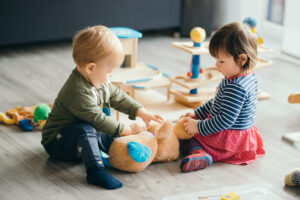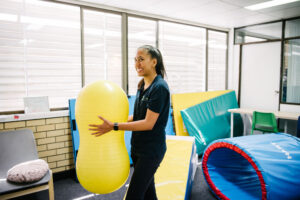The importance of childhood play!
Why focus on helping your child develop play skills?
Children begin to engage in play activities from early infancy. This might look like playing peekaboo with mum and dad, being lifted and spun in the air or imitating mum and dad’s actions.
Play is a crucial element of a child’s development and allows them to learn about the world around them. What may seem to be a simple way for children to entertain themselves, is actually a highly complex learning process.

Play provides an immense opportunity for children to learn about all areas of life.
Play supports children to identify how their actions affect others and the environment around them through engagement in cause and effect play, and supports the development of social skills through interactions with others. In addition to this, play is a key way that children identify and accept their own likes and dislikes.
Play should be pressure and anxiety free.
This allows for children to trial new things, make mistakes in a low risk environment, learn from their mistakes and also allows them to explore what they’re capable of.
The skills which children learn through play set them up for the years ahead.
Skills that play helps develop
- Cognitive skills: understanding the world & thinking skills
- Language development: explaining, negotiating, storytelling
- Motor Skills: Fine motor, gross motor and postural control
- Problem solving: attention, ideation (generation of ideas),initiation, sequencing, working memory, planning and organisation
- Social/emotional skills: turn taking, sharing, understanding basic emotions
- Environmental learning: exploration and experimentation
What does play look like?
It’s important to note that the way that children play is diverse and unique. Children can play in many different ways.
 7 Types of play to encourage at home!
7 Types of play to encourage at home!
- Pre-imaginative play involves young children engaging in activities such as peek-a-boo, ball rolling and kicking, and hiding of objects under everyday items such as a blanket or rug.
- Pretend play involves children using realistic objects to act our familiar actions, such as those which have been seen around the house. For example, children may pretend to feed a doll with a spoon, or tuck a teddy into bed. Pretend play is essential for the development of representational thinking, creativity, problem solving and social and narrative skills.
- Object substitution during play involves children using an object in another way for which it was originally intended. This could look like using an empty box as a bed, or using a stick as a spoon to feed a doll. Object substitution during play supports children to develop flexibility, representational thinking and problem solving skills.
- Engaging in role-play where the child begins to play the role of another person. For example, pretending to be a parent or pretending to be a doctor. Role play is essential for the development of theory of mind, social interaction, emotional engagement and narrative skills.
- Playing with dolls and teddies as if they are alive. For example, providing dolls/teddies with a cup to drink from, hugging the doll/teddy or providing them with a chair to sit on. Engagement in doll/teddy play supports children to develop theory of mind, creativity, metacognition and problem solving skills.
- Engaging in constructional play by using blocks or Lego to organise, plan and build different structures. This aids in developing executive functioning skills, particularly planning and organisation of materials, as well as regulation skills to cope with difficulties during constructional tasks.
- Participation in cause and effect play. This might look like engaging in activities such as a marble run or ball tower, or also repeatedly building a tower before knocking it over. Engagement in cause and effect play supports understanding of consequences and development of self-regulation and narrative skills.
Play is the way in which children learn about their world and about themselves.
Sometimes it can be challenging to identify if your child needs support to develop their play skills. If you have any concerns about your child’s engagement or development in play or if you would like more information about play, please feel free to contact us to chat with our Occupational Therapists.

Edited and updated by Kiara Moodley, 2023 (Occupational Therapist)
Originally written by Bre Surawski, 2018 (Occupational Therapist)
References
Bracegirdle, H. (1992). The Use of Play in Occupational Therapy for Children: What is Play? British Journal of Occupational Therapy. 55 (3), 107-108. doi:10.1177/030802269205500309
Couch, K.J, Dietz, J.C, Kanny, E.M. (1988). The Role of Play in Pediatric Occupational Therapy. Am J Occup Ther. 52 (2), 111-117. https://doi.org/10.5014/ajot.52.2.111
Stagnitti, K. & Unsworth, C. (2000). The Importance of Pretend Play in Child Development: An Occupational Therapy Perspective. British Journal of Occupational Therapy. 63 (3), 121-127. doi:10.1177/030802260006300306
Stagnitti, K. (2021). Learn to Play Therapy: Principles, Process and Practical Activities. Learn to Play.
